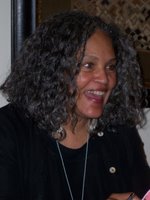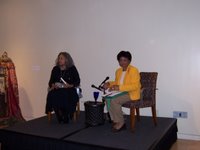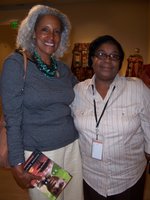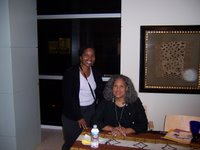Classically Savion @ Cal Performances Friday night

There was as usual too much to do Friday night in the San Francisco Bay Area but I chose to go check out Classical Savion, the tap wiz who took European classic music back to its roots. I was supposed to see a play... sorry Kim for reneging without RSVPing. I didn't have your number on me. The house was full, subscription base the folks who were looking for Fred Astair and found Kunta Kente. Brother Glover was freestyling on the drums, his feet a percussion ensemble which meshed so well with the string orchestra, the relationship between musicians and dancer in the moment.
Though rehearsed, the pieces felt improvasional/new as Glover twirled around on his toes, kept a steady beat without seeming to move, then when he did, it felt like a train was pulling into a station.
This really talkative white man, a friend of Glover's he said, was next to me. He called himself filling the black girl in on black culture. Drunk, I wasn't certain what level of unconsciousness was operating there. I had to tell him to be quiet. He was distracting and rude, but not as visibly rude as all the people who started to leave as Glover shifted into his last piece Stars and Stripes Forever 4 Now.
Glover was scatting, singing as well as tapping on this obviously inspired number; however, Laura Elaine Ellis, choreographer, dancer, whom I saw afterwards, said she would have liked it if Glover had stopped just for a moment and made choreo-statement on the war in Iraq, Lebanon, the Gulf Region, New Orleans -- anything, then resumed the show.
But I think his entire show was a statement.
I heard Africa in his feet traveling to Western Europe and claiming a heritage which is not limited to one specific geographic region. Dredlocked hair looped into a bun at his neck, smile on his face, Glover stumped, skated, bobbed his head, the smile on his face reminding me of the late Billy Higgins seated behind traps, playing his way to heaven.
The ten member string ensemble performed easy listening favorites --not that they were easy, like Vivaldi's Four Seasons; Dvorak's American Quartet, Bach's Brandenburg Concerto No. 3 in G major, Bartok's Rumanian Folk Dances, Sz. 68, BB 76, Shoskovich's String Quartet No. 8 in C minor, Op. 110, and Mendelssohn's Octet for Strings in E-Flat major, Op. 20.
It was cool watching the dancer interpret these melodies rhythmically -- I'll never hear a classical concert quite the same ever again after this.
Sister Maxine Roach, viola, told a few of us after that the orchestra had been assembled for this tour. Yet, they played marvelously, like they'd been together for years. Similar to a jam session, Glover was literally flying across the stage at times. The amplified platform recreated what it might have sounded like if Glover were dancing on a drum: snare, bass and tom, and the occasional crash of the cymbal, all heard in his feet.
With perspiration leaking through his shirt(s) to the point on the third and final pause it took him longer to return than the first and second go-round. He might have had to take a quick shower.
While he was changing, the bass player (a part of the classical and jazz set) began playing a song that Savion came out dancing to. The choreographer then introduced the orchestra and they all played a solo.
Besides the sister on viola whose Motherless Child...was, well you should be happy they're going to Montalvo, just down the road at UC Davis, were some cool violinists -- men and women...reminded me of Oakland East Bay Symphony, the orchestra could stretch and flex their creative muscles. In great shape, they all demonstrated their creative dexturity: cellists, viola players and bassist and of course violinists.
Glover created an accompanying dance to respond to their riffs on classical songs and music created in the moment. They were jamming!
Between the solos he brought on his pianist, who was cool. The pianist intro a greeting to an old friend -- you could tell The Otherz member knew the dancer well, as another member of the jazz ensemble, the fluist/soprano saxophonist came back, then drummer, Jared Chocolatt, was introduced. Jared was last seen at Contra Costa College Theatre in Hit It!(See wandaspicks.com).
Later on, this sister was raving over the band like she's been to church, or seen the Lord, or maybe both. Her response was something the evening lacked...I'd have to agree with my drunk companion there who got up before the final song and left...disgusted.
The audience wasn't getting it. Too bad the balcony couldn't have filled in all the empty seats where I was. I think the folks who felt the groove, recognized the themes...when Savion brought in riffs from a variety of genres, like hip hop, jazz and blues...were all in the cheap seats.
He needed to be at the Ashby Flea Market, at the Malonga Center, at the African American Culture Complex, at Ashkenaz. He needed an audience with educated ears, not drunk white men who thought they knew best, or the older predominately white audience who didn't get it and didn't want to either.
Calling Savion Glover a protégée of Fred Astair is an insult.
If Glover had gotten the kind of audience reponse our brothers in the circle get when they trade codes and whisper secret messages, maybe he'd have sang a little longer, made that statement Laura Elaine wanted to hear...but well the folks were a bit too sedate or absent and when he jumped off the stage, bowed and waved...that's it. That was it.
The orchestra is headed to Davis for Sept. 28, 7:30 p.m.,Garden Theatre, Montalvo, then to UCLA, UC San Diego... Davis is the closest, so get your tickets now. For the Davis gig tickets are $35/40/45/55/65.
Visit http://www.villamontalvo.org/eventdetails.asp?i=442. There's a link to Glover's official website there.










